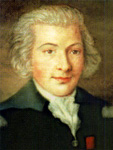Jean-Baptiste, Marquis de Traversay

Naval commander
Born: Martinique - 4 July 1754
Died: Romanschina, Leningradskaya Oblast, Russia - 19 May 1831
One of several foreign commanders invited to join the Russian Imperial Navy under Catherine the Great, Jean Baptiste Prevost de Sansac was probably the most successful, establishing a career in high government that lasted through the reign of Alexander I. The son of a French naval officer and a sugar plantation owner in Martinique, Traversay was schooled at naval colleges in France and began his career on transport ships to the Caribbean.
After rising through the ranks of the French Navy, he became a hero of the American Revolutionary War. With the onset of the French Revolution and the disintegration of the French Navy, Traversay accepted an invitation from another emigre Frenchman, Prince Nassau-Siegen, to join the Russian Imperial Navy in 1791. He was immediately made a Major General and Rear Admiral of the Russian Empire. Political in-fighting between factions of the high command in the Russian Navy meant that he was unable to immediately take up duties in St. Petersburg, and he was sent as a liaison between the Russian Court and the emigre Army of Conde.
He returned to St. Petersburg in 1793, and in 1795 was appointed commander of a flotilla based at Rochensalm (now Kokta in Finland). The new emperor Paul I, was impressed with his service and appointed him military governor of Rochensalm in 1797. Under Paul's successor Alexander I, Traversay was appointed commander of the Black Sea Fleet and governor of Kherson Oblast in 1802. There he strengthened the fleet as well as acting as chief of defense for Crimea and the Taman Peninsula in the Russo-Turkish War of 1806-1812, where he saw the last military action of his carrer at the Siege of Anapa. Traversay was recalled to St. Petersburg in 1809 and appointed Minister of Naval Affairs. In 1811, he became a full Russian citizen.
As Minister, Traversay reorganized the Baltic Fleet, creating the structure of regimental-sized "fleet crews" that proved effective in the Napoleonic Wars and remained the basis of the Russian Navy until the October Revolution. He also sponsored major expeditions to the Arctic and Antarctic, and his name was given to the Traversay Islands, discovered by Thaddeus von Bellingshausen in 1819. Markizova Luzha (the "Marquis's Puddle") became the popular name of the shallow waters in the western part of the Gulf of Finland, where the much depleted fleet was forced to train after the Napoleonic Wars, and is still used to this day.
Traversay remained Minister into the reign of Nicholas I, despite begging leave to retire, and received numerous awards, among them the Order of St. Andrew and the Order of St. George. His last major work was to supervise the rebuilding of the Baltic Fleet after the disastrous flood of 1824. He finally retired in 1828, and died at his home estate in Romanschina in 1831. His three sons, one of whom was the grandson of Catherine the Great, all served in the Russian Imperial Navy.
Connected with: Thaddeus von Bellingshausen, Prince Nassau-Siegen

